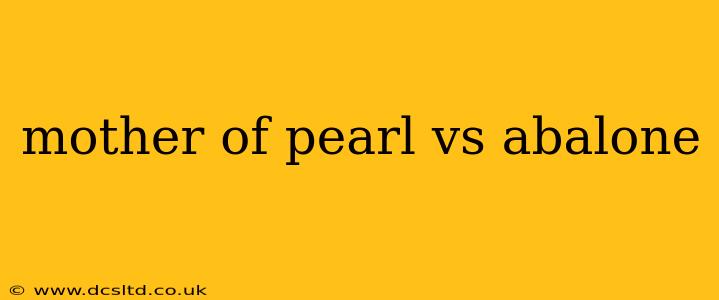Mother of pearl and abalone are both stunning natural materials prized for their iridescent sheen and often used in jewelry, decorative items, and even musical instruments. While they share a similar pearlescent quality, there are key distinctions between them. This article will delve into the differences in their origins, appearance, properties, and uses to help you appreciate the unique beauty of each.
What is Mother of Pearl?
Mother of pearl, also known as nacre, is the inner layer of certain mollusks' shells, including oysters, mussels, and freshwater pearls. It's formed through a process of biological layering, where the mollusk secretes calcium carbonate and conchiolin (a protein) to create the smooth, iridescent surface. The subtle interplay of light reflecting off these layers creates the characteristic shimmering effect. The color of mother of pearl varies depending on the species of mollusk, ranging from creamy white and pale pink to subtle blues and greens.
Is Mother of Pearl a Gemstone?
While not technically a gemstone in the traditional sense (as gemstones are crystalline minerals), mother of pearl is often considered a precious material due to its beauty and rarity of certain types. Its use in jewelry and high-value objects elevates its status beyond a simple shell.
What is Abalone?
Abalone is the inner shell of a specific type of marine snail, also known as the abalone sea snail. Similar to mother of pearl, abalone's iridescence arises from the layered structure of its shell. However, abalone shells display a more intense and vibrant iridescence, with a wider spectrum of colors often including greens, blues, pinks, and purples. These colors are frequently more vivid and bolder than those found in most mother of pearl.
How Can You Tell the Difference Between Abalone and Mother of Pearl?
The most noticeable difference lies in the intensity and range of colors. Abalone typically displays a more dramatic and vibrant iridescence, often featuring a wider array of colors within a single shell. Mother of pearl is usually softer and more subdued in its color palette. Abalone's surface also tends to have a more pronounced, sculpted texture compared to the smoother surface of mother of pearl.
Mother of Pearl vs. Abalone: A Comparison Table
| Feature | Mother of Pearl | Abalone |
|---|---|---|
| Source | Various mollusks (oysters, mussels, etc.) | Abalone sea snail |
| Color | Cream, white, pale pink, subtle blues/greens | Vivid greens, blues, pinks, purples |
| Iridescence | Subdued, shimmering | Intense, vibrant, often multi-colored |
| Texture | Generally smoother | Often more textured and sculpted |
| Hardness | Relatively softer | Relatively harder |
| Value | Varies depending on species and quality | Generally more valuable than most mother of pearl |
How are Mother of Pearl and Abalone Used?
Both mother of pearl and abalone are prized for their beauty and used in a wide variety of applications, including:
- Jewelry: Buttons, necklaces, earrings, brooches
- Decorative Arts: Inlays, boxes, picture frames
- Musical Instruments: Guitar inlays, drum embellishments
- Knife Handles: High-end knives sometimes feature abalone or mother of pearl handles.
What is the most expensive type of mother of pearl?
The cost of mother of pearl and abalone depends greatly on factors such as the species of mollusk, the quality of the iridescence, and the size and shape of the piece. Certain rare and high-quality mother-of-pearl varieties, particularly those with unique color patterns, can command high prices. Similarly, large, flawlessly iridescent pieces of abalone are highly sought after. Determining the "most expensive" is subjective and market-dependent.
Are Abalone and Mother of Pearl Sustainable?
The sustainability of both abalone and mother of pearl harvesting is a critical concern. Overfishing and unsustainable harvesting practices have led to population declines in some abalone species. Therefore, it's crucial to support suppliers and manufacturers who utilize ethically sourced materials and engage in sustainable practices. Look for certifications or information regarding responsible sourcing when purchasing items made from these materials.
By understanding the nuances of mother of pearl and abalone, you can better appreciate the unique beauty and craftsmanship that go into objects created with these exquisite materials. Remember to always prioritize ethical and sustainable sourcing when making your purchases.
